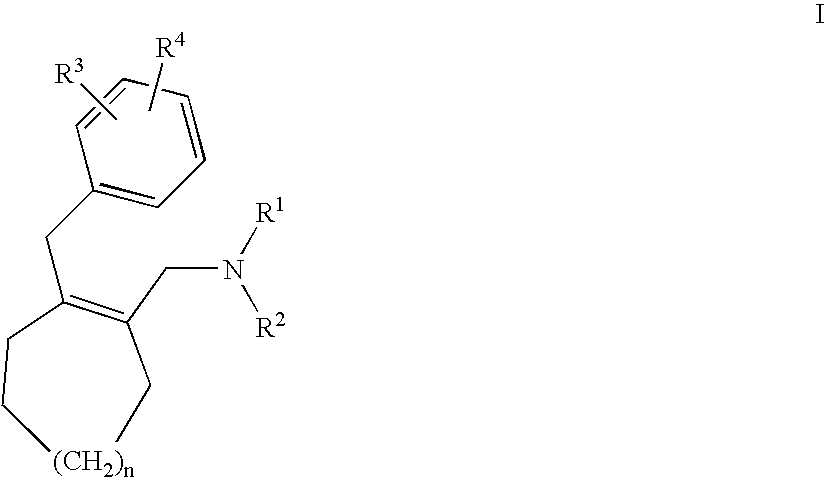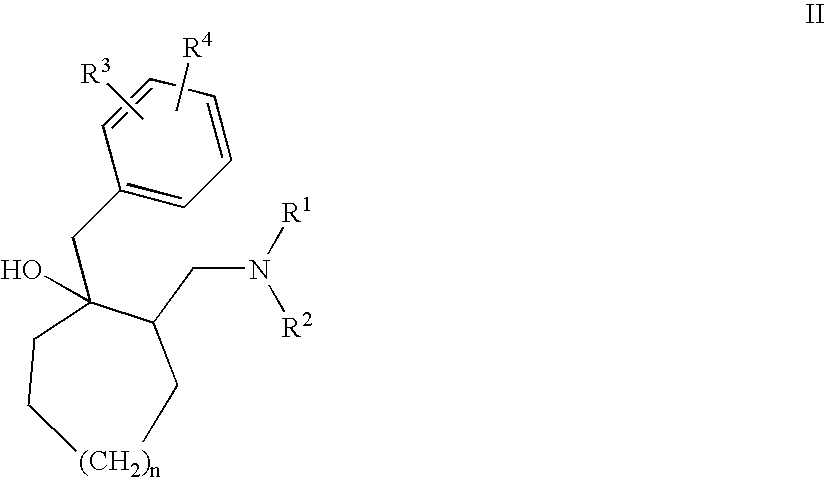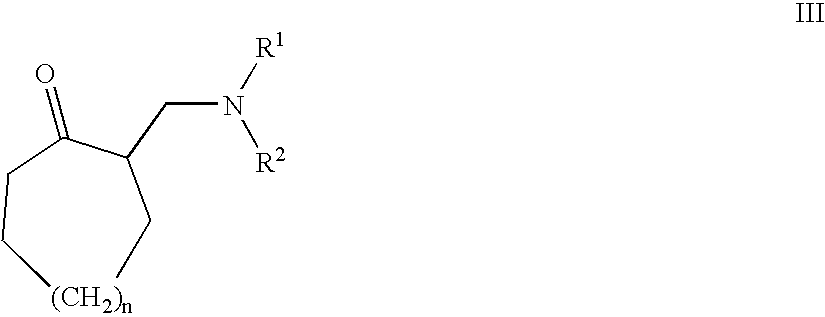Substituted amino compounds as 5-HT/NA uptake inhibitors
a technology of amino compounds and inhibitors, which is applied in the field of substitution of amino compounds, can solve the problems of disadvantage, high relapse rate, and inability to take action in 20-30% of patients, and achieve the effect of improving the action profile and improving the tolerability
- Summary
- Abstract
- Description
- Claims
- Application Information
AI Technical Summary
Benefits of technology
Problems solved by technology
Method used
Image
Examples
example 1
[2-(4-Chlorobenzyl)-cyclohept-1-enylmethyl]-dimethylamine; hydrochloride
[0037] Step 1:
1-(4-Chlorobenzyl)-2-dimethylaminomethyl-cycloheptanol
[0038] A solution of 32.00 g of 2-dimethylaminomethylcycloheptanone in 190 ml of absolute diethyl ether was added dropwise at 20° C., with stirring, to a freshly prepared solution of the Grignard reagent comprising 6.17 g of magnesium turnings and 40.50 g of 4-chlorobenzyl chloride in 500 ml of absolute diethyl ether. When the addition was complete, stirring was continued for a further 2 hours at 20° C. Decomposition was then effected, while cooling with ice, by the dropwise addition of 100 ml of a saturated ammonium chloride solution followed by 200 ml of distilled water. The organic phase was separated off, and the aqueous phase was extracted twice using 200 ml of ethyl acetate each time. The combined organic extracts were washed with saturated sodium chloride solution, dried over sodium sulfate and concentrated by evaporation in vacuo. T...
example 2
[0043] Following the procedure described in Example 1 and using 2-dimethylaminomethyl-cyclopentanone or 2-dimethylaminomethyl-cyclooctanone instead of the corresponding cycloheptanone derivative in Step 1, the following were obtained in an analogous manner:
[0044] a)
[0045] [2-(4-chlorobenzyl)-cyclopent-1-enylmethyl]-dimethylamine; hydrochloride [0046] melting point: 191° C.
[0047] b)
[0048] [2-(4-chlorobenzyl)-cyclooct-1enylmethyl]-dimethylamine; hydrochloride [0049] melting point: 234-237° C.
example 3
[2-(4-Chlorobenzyl)-cyclohept-1enylmethyl]-methylamine; hydrochloride
[0050] 0.19 g of the product from Example 1 in the form of the free base was heated at reflux for 2 hours with 0.1 ml of chloroformic acid phenyl ester in 12 ml of anhydrous toluene. After cooling, washing was carried out with, in succession, 2.5 N sodium hydroxide solution, water, 1N hydrochloric acid or a saturated sodium chloride solution, followed by drying over sodium sulfate. Concentration by evaporation was carried out in vacuo, and the resulting residue was taken up in 6 ml of ethylene glycol and heated for 4.5 hours at 110° C. with 1.4 ml of 5N sodium hydroxide solution. After cooling, the mixture was diluted with 20 ml of water and extracted three times using 10 ml of dichloromethane each time. The extracts were washed with saturated sodium chloride solution and dried over sodium sulfate. Concentration by evaporation was carried out in vacuo, and the resulting oily residue was converted into the hydroch...
PUM
| Property | Measurement | Unit |
|---|---|---|
| temperature | aaaaa | aaaaa |
| temperatures | aaaaa | aaaaa |
| temperatures | aaaaa | aaaaa |
Abstract
Description
Claims
Application Information
 Login to View More
Login to View More - R&D
- Intellectual Property
- Life Sciences
- Materials
- Tech Scout
- Unparalleled Data Quality
- Higher Quality Content
- 60% Fewer Hallucinations
Browse by: Latest US Patents, China's latest patents, Technical Efficacy Thesaurus, Application Domain, Technology Topic, Popular Technical Reports.
© 2025 PatSnap. All rights reserved.Legal|Privacy policy|Modern Slavery Act Transparency Statement|Sitemap|About US| Contact US: help@patsnap.com



